|
 Austropaxillus squarrosus Austropaxillus squarrosus
SynonymsPaxillus squarrosus
Paxillus subdefibulatus
BiostatusPresent in region - Indigenous. Endemic
Images (click to enlarge)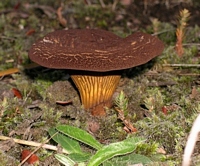
Owner: J.A. Cooper | 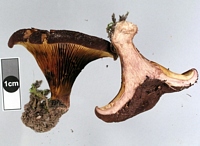
Owner: J.A. Cooper | 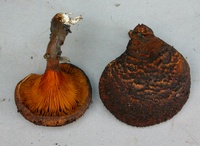
Owner: P. Leonard | 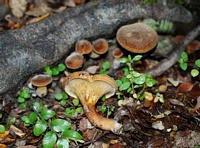
Owner: J.A. Cooper | 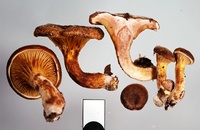
Owner: J.A. Cooper | 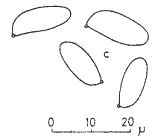
Caption: P. squarrosus: spores. | 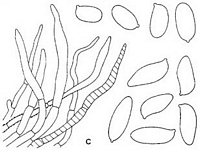
Caption: McNabb (ZT 68/356): spores, cuticle. | 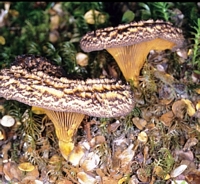
Caption: Arthurs Pass National Park, 1991
Owner: P.R. Johnston | 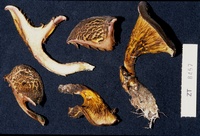
Caption: ZT8457
Owner: E. Horak: © Creative Commons Attribution-Noncommercial 3.0 New Zealand | 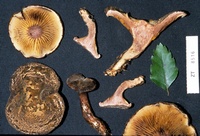
Caption: ZT8516
Owner: E. Horak: © Creative Commons Attribution-Noncommercial 3.0 New Zealand | 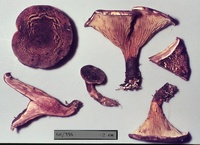
Caption: ZT68-356
Owner: E. Horak: © Creative Commons Attribution-Noncommercial 3.0 New Zealand |
Article: McNabb, R.F.R. (1969). The Paxillaceae of New Zealand. New Zealand Journal of Botany 7(4): 349-362 (http://www.rsnz.org/publish/abstracts.php).
Description: PILEUS: convex when young, centrally depressed, infundibuliform, irregularly
infundibuliform, or occasionally spathulate at maturity, 3-10.5 cm diam., dry,
velutinate when young, often circumferentially creviced or minutely to coarsely
squarrose and exposing the yellowish context at maturity, mustard brown, dark
rusty brown, dark cinnamon brown, chestnut brown or cocoa brown, often paling
slightly towards margins; cuticle a trichodermium, composed of erect, filamentous
hyphae with simple septa and dark brown contents, terminal cells cylindrical
or tapering apically, thin-walled or slightly thick-walled, often externally
roughened, 5-15 µm. diam.; margins strongly involute when young, moderately
involute and often undulate and irregularly lobed at maturity, sometimes with
a sooty appearance where the cuticle has separated into minute areolae. LAMELLAE:
moderately crowded, deeply decurrent, repeatedly dichotomously branched 4-(6)
times, not anastomosing or meruloid near stipe, to 6mm deep, golden yellow to
ochraceous yellow at maturity, discoloured dark reddish brown where damaged,
lamellulae absent. STIPE: 1-4.5 cm long, subequal or tapering basally, 1-2 cm
diam. apically, 0.5-1.5 cm diam. basally, central or occasionally eccentric,
solid or slightly hollowed at maturity, dry, coarsely velutinate to tomentose
by presence of filamentous, septate hyphae with brown contents, concolorous
with lamellae apically, more or less concolorous with pileus basally; basal
mycelium white; flesh sordid yellowish brown, rapidly turning reddish brown
on exposure to air; veil absent.
SPORES: spore print orange-brown (Amber Brown); spores golden
melleous to bright rusty brown, broadly elliptic-subfusiform, suprahilar depression
or applanation occasionally present, apiculate, germ pore absent, 9.8-13-(14.5)
X 4.8-5.5-(6.5) µm., moderately thick-walled, smooth. HYMENIUM: basidia hyaline
or tinted yellow with yellow contents, subclavate to clavate, 40-60 X 7.5-10.5
µm., (2)-4-spored; cystidia absent. HYMENOPHORAL TRAMA: bilateral, mediostratum
of moderately loosely interwoven hyphae and oleiferous hyphae, lateral stratum
of more closely interwoven hyphae; clamp connections absent. CONTEXT OF PILEUS:
sordid yellowish to yellowish white, rapidly turning reddish brown on exposure
to air. SMELL: not distinctive. TASTE: bitter. CHEMICAL CHARACTERS: KOH on pileus—deep
reddish brown; on context—yellow or reddish yellow; NH4OH on pileus—deep reddish
brown with red flush; on context— yellow.
Habitat: HABITAT : Gregarious or caespitose under Nothofagus.
Notes: The absence of both clamp connections and a veil indicate that Paxillus squarrosus
belongs in sect. Defibulati as defined by Singer (1962). It is closely
allied to P. statuum (Speg.) Horak, a species associated with Nothofagus
in South America, but differs in the typically dark brown pileus, repeatedly
dichotomously branched lamellae, brown velutinate to tomentose stipe, and slightly
smaller spores. Differences also occur in chemical characters. Horak (1967)
has recently shown that P. statuum is an earlier name for P. defibulatus
Singer, the type species of sect. Defibulati.
P. squarrosus is readily distinguishable from other endemic species
by the dark brown, typically squarrose pileus, and the yellowish context, which
stains reddish brown on exposure to air.
Article: Horak, E. (1980) [1979]. Paxilloid Agaricales in Australasia. Sydowia 32: 154-166.
Notes: This species is closely related to P. statuum (SPEGAZZINI) HORAK, a very common fungus in the Nothofagus forests of Chile and Argentina (HORAK 1980).
|